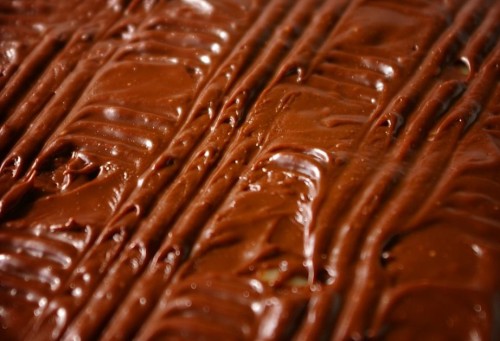
Go with the flow: physicist Rogjia Tao has a clever way to cut the fat in chocolate. (CC BY-SA 2.0/rore)
By Matin Durrani in Baltimore, Maryland, US
A couple of years ago my colleague James Dacey decided to give up eating chocolate, crisps, biscuits and cakes over Lent and it’s a virtuous – if very dull – decision I’ve been following every year since (even if James has long since strayed from the path of righteousness).
It was therefore with a dollop of smug satisfaction that I attended a talk at this year’s APS March meeting by Rongjia Tao – a physicist from Temple University in the US. He has developed a way of cutting the amount of fat in chocolate without, apparently, losing any of the taste.
Now, reducing the fat content in chocolate might seem straightforward – you just get rid of the fat, right? But it’s a harder problem than you’d think for chocolate manufacturers, who have to send liquid chocolate – a suspension of spherical cocoa particles in a melted fat of cocoa butter and other oils – down pipes and tubes.
The difficulty is that liquid chocolate has an unusual viscosity behaviour, or rheology. When there’s not much cocoa, the viscosity is fairly constant. But as soon as the concentration of cocoa reaches about 50%, the viscosity starts rising.
And once it goes above 64% – the maximum packing density of spheres in a liquid – the viscosity gets so high that the chocolate cannot flow at all. Instead it jams the pipes. Which is bad news for chocolate companies, who have to somehow get rid of that stodge.
What all that means is that you can’t make chocolate with less than 36% fat or you’ll bung up your pipes. Tao, however, has a solution. If you send liquid chocolate through an electric field, you can polarize the cocoa particles so that groups of them line up to make short chains.
The maximum packing density now becomes more like 72%, which means that you can have more cocoa – and hence less fat – in chocolate before you reach the dangerous bung-up-your-pipes regime. And chocolate with 28% fat is a reduction of a fifth over chocolate with 36% fat.
It’s not a huge difference but Tao thinks it could help tackle the desperate obesity crisis in some developed nations. What’s more, Tao reckons that some people think the chocolate actually tastes better as there’s more cocoa in it, though he admits “more tests are needed”.
His university has taken out patents on the research, which has not yet been published in a scientific journal. But Tao was tight-lipped about when we might see real products with this new low-fat chocolate. In the meantime, if you want to cut your fat intake from chocolate – do what I do and just don’t eat it.
Out of interest how have companies like Lindt been manufacturing bars of >72% cocoa before this method?